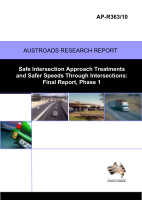Road Design

- Publication no: AP-R363-10
- ISBN: 978-1-921709-42-5
- Published: 17 November 2010
- PDF (free) Download
The aim of this project is to investigate intersection crashes with a view to determining suitable intersection approach treatments, and opportunities for better managing speeds through intersections, so as to reduce the severity of intersection crashes. The fundamental purpose of the study is to provide advice on how to improve the safety of intersections by treating the approaches and by achieving safer vehicle travel speeds through the intersections.
This study will also provide an opportunity to extend engineering knowledge in areas of Safe Speeds (control of intersection approach speeds) and Safe Roads (design features), as elements of the Safe System philosophy.
The majority of crashes in urban areas, and a substantial proportion of crashes in rural areas, occur at intersections. Previous studies have identified a number of key factors contributing to occurrence of casualty crashes at these locations: traffic flow, pedestrian and cyclist activity, intersection layout, type of intersection control, speed limit and operating speeds.
- 1. INTRODUCTION
- 2. PROJECT OUTLINE
- 2.1. Purpose
- 2.2. Method
- 2.3. Report
- 3. INTERSECTION SAFETY
- 3.1. Problem Definition
- 3.2. Speed Within a Safe System Context
- 4. SPEED AT INTERSECTIONS
- 4.1. NCHRP Report 613
- 4.2. Crash Prediction Models
- 4.3. Gap Acceptance
- 4.4. Summary
- 5. ROAD-RELATED FACTORS AFFECTING SPEEDS
- 5.1. General
- 5.2. Rural Roads
- 5.2.1. Typical Speed Values
- 5.2.2. Effect of Trip Distance
- 5.2.3. Effect of Road Factors
- 5.3. Urban Roads
- 5.3.1. Arterial Roads
- 5.3.2. Local Street Networks
- 6. POSSIBLE TREATMENTS
- 6.1. Speed Change or Speed Maintenance
- 6.2. Speed Reduction Treatments
- 6.2.1. Gateway Treatments
- 6.2.2. Horizontal Impedance and Deflection
- 6.2.3. Vertical Response
- 6.2.4. Audio/Tactile Surface Treatments
- 6.2.5. Passive Perceptual Countermeasures
- 6.2.6. Warning Treatments
- 6.2.7. Combining Treatments
- 7. RURAL INTERSECTION TREATMENTS
- 7.1. Rural Networks
- 7.2. Roundabouts
- 7.2.1. Crash Reduction Potential
- 7.2.2. Speed Reduction Prior to Roundabout
- 7.2.3. Practicality
- 7.3. Stop or Give-way Controlled Intersections
- 7.3.1. Intersections Between Local Roads
- 7.3.2. Arterial Road/Local Road Intersection
- 7.3.3. Arterial/Arterial Intersections
- 7.3.4. City Hinterland Regions
- 7.4. Signalised Intersections
- 7.5. Summary
- 8. URBAN INTERSECTION TREATMENTS
- 8.1. Roundabouts
- 8.1.1. Arterial Roads
- 8.1.2. Sub-arterial Roads
- 8.2. Signal Controlled Intersections
- 8.3. Stop or Give-way Controlled Intersections
- 8.4. Local Network Intersections
- 8.5. Summary
- 9. POTENTIAL ITS TREATMENTS
- 9.1. Objectives for ITS Treatments
- 9.2. ITS Treatments Aimed at Intersection Speeds
- 9.3. ITS Treatments Aimed at Speeds Generally
- 9.3.1. Intelligent Speed Assist (ISA)
- 9.3.2. Enforcement
- 9.4. Summary
- 10. DISCUSSION: RESULT OF LITERATURE REVIEW
- 10.1. Roundabouts
- 10.2. Warning Treatments
- 10.2.1. Traditional Treatments
- 10.2.2. Innovative Treatments
- 10.3. Road Humps
- 10.4. Four-way Stop Control
- 10.5. Prevailing Link Speeds
- 10.6. Conclusions from Literature Review
- 11. CRASH DATA ANALYSIS
- 11.1. Introduction
- 11.2. Scope and Limitations of Crash Data and Analysis
- 11.3. Speed Related Intersection Crashes by Jurisdiction
- 11.4. Crash Characteristics
- 11.4.1. Urban and Rural Environments
- 11.4.2. Time of Day and Light Conditions
- 11.4.3. Weather Conditions
- 11.4.4. Speed Limit
- 11.4.5. Road Surface
- 11.4.6. Vertical Alignment
- 11.4.7. Horizontal Alignment
- 11.4.8. Intersection Type
- 11.4.9. Traffic Control
- 11.4.10. Crash Movement
- 11.4.11. Vehicle Type
- 11.4.12. Object Struck
- 11.5. Summary of Crash Analysis
- 12. SITE INSPECTIONS
- 12.1. Site Selection
- 12.2. Features Investigated
- 12.3. Indications from Site Inspections
- 12.4. Summary of Contributing Crash Factors
- 13. CONCLUSIONS
- REFERENCES
- Appendix A Sites investigated
- Appendix B Inspection sheet
- Appendix C Contributing crash factors
